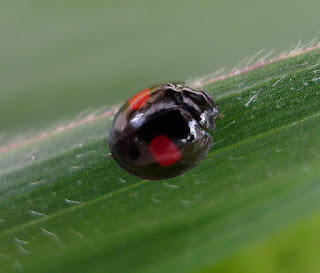 |
| Kidney spot ladybird, as seen in OJ16 this week. It's a beetle too. CC image by GailHampshire. |
Yesterday afternoon, student B and I had a go at identifying some of her beetles. It really was a triumphant success and she kindly said she felt a lot more confident about the process. I had a very pleasant afternoon and I think we both felt the geeky satisfaction of tracking a specimen through the keys and coming out at the right answer.
However, I thought I would mention here that this was not a speedy process. I've done some beetle i.d. before and so I was able to explain the terminology as it came up, pointing out the different parts of the beetle's body and showing her the classic beetle dichotomy of Crossed vs. Uncrossed Epipleura. So this speeded things up for her. But in three hours we identified three specimens. Yes this included faffing about finding microscopes, pins, printing off keys and chatting about other things. But you should still be aware that (at least to begin with) identifying your beetle (or spider for that matter) is going to take time. Do not leave things until the last minute.
Besides, we were enjoying the process, looking at the amazing detail of the beetles down the microscopes - they were surprisingly hairy, or stripey-lined, or with massive jaws, or with crazy antennae. So it was a pleasure to spend the time looking at them. Please do come and use the microscopes to examine your species, and I am only too happy to go through the identification with you. It's really useful to have two pairs of eyes to judge some of the characteristics.
We started off each time with Unwin's guide to families:
B's first specimen was huge, so much so that we initially tried to convince ourselves that the key was taking us towards the elbow-antennaed Lucanidae (stag beetles). But reason and logic prevailed. The short elytra (wing covers) led us to the Silphidae (burying beetles).
The extremely philanthropic Mike Hackston has an illustrated key to the Silphidae. And once we had got down to the right genus, his key for Nicrophorus led us to the answer: Nicrophorus humator. Fair enough, with a common species like this one, you might have been able to pick it out of the photos in a general insect guide. But you wouldn't have gleaned useful beetle-observing skills along the way and you might not have looked closely enough at the details that distinguish it from similar species.
 | |||
| CC image by Laisverobotams. |
Our next specimen also had short elytra, showing even more abdomen. But its antennae were quite different. We used Unwin's key to put it in the Staphilinidae family - this contains about a quarter of British beetles! but luckily this species is very distinctive and we felt justified deferring to this excellent Watford Coleoptera Group page confirming its size makes it impossible to be anything other than the Devil's Coach Horse (Ocypus olens). It does seem beetles get all the best names.
 |
| The Devil's Horse Coach gets uppity. CC image by Galway Girl. |
Finally we chose another black beetle from B's collection. It had long thready antennae, elytra that covered its whole abdomen, 'trochanters' underneath, and five tarsi on its front, middle and back legs. This made it a ground beetle - within the family Carabidae. Once again the keys generously provided by Mike Hackston were invaluable. By steadily working through questions about the shape of its various parts, counting stripes and squinting for the existence of tiny hairs, we were at last able to confidently name it Pterostichus niger.
 |
| CC image by AfroBrazilian. |
Naturally we recorded all we were looking at as we went along, drawing little sketches and writing down the reference numbers of the keys. Not only will this get you some marks for your notebook, it'll be a good reminder of all your previous beetles' features when you come to your next specimen.
A little note: you're welcome to come in whenever the university's open and sit in our lab. But just to say, I'm away on an exotic field trip for two weeks and will be back after Easter. I know. It's a hard job. And then you have three weeks to finish your collections. Let me know if you'd like my assistance and when.




